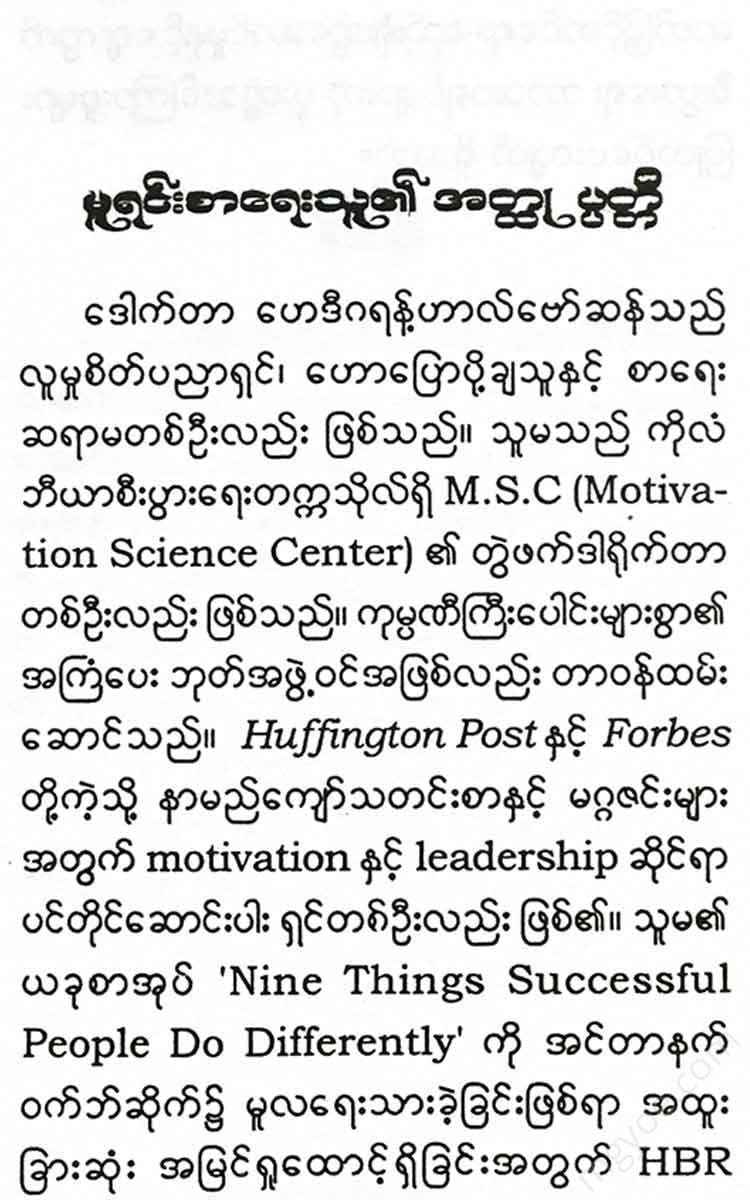စိတ်ကူးချိုချိုစာပေ
Zeratul - 9 ways to be successful
Zeratul - 9 ways to be successful
Couldn't load pickup availability
1. Be specific.
When you set a goal for yourself, try to be as specific as possible. It’s better to set a goal like “I want to lose 5 pounds” than “I want to lose weight.” It gives you a clear picture of what you want to achieve. Knowing exactly what you want will keep you motivated until you get it. And think about each action you need to take to achieve your goal. Just promising to “eat less” or “get enough sleep” is too vague. Be specific. If you say “I’ll go to bed at 10 p.m. on weekdays,” there’s no more uncertainty about whether you’ll actually do it or not.
Whenever I ask people about their goals, they say things like, “I want to be the best at my job,” “I want to be healthier,” etc.
"I will succeed," "I will spend less and save more." When they give me answers like that, I ask, "Okay, so what does success look like? How do you know if you have reached your goal or not?" At that point, they become silent for a long time, and they become unsure and unsure.
Many people are like that. Then they admit, "I didn't think about it."
Taking the time to be specific about what you want and what you want eliminates the need to tell yourself that you’re not bad. It also makes it clearer what steps you need to take. (If my goal is “I want to have a better relationship with my mom,” it’s not obvious what I need to do to make that happen. But if I were more specific and set a goal like “I’m going to talk to my mom at least twice a week,” I’d know exactly what I need to do and how to do it.) Research shows that being specific is the most important step in achieving any goal. People often forget this.
Instead of the goal of “I must succeed at work,” set a more concrete goal like “I must have a salary increase of at least ….” (or “I must be promoted to ….”) If you are not sure what you are working towards, you will become lazy and discouraged, and you will become complacent.
It's easy to get sidetracked. But if you have a clear goal in mind, you can't fool yourself because you know if you're going to achieve it. If you're not going to achieve it, and you still want to succeed, you have no choice but to keep trying.
Being specific about what you want is just the first step. Next, you need to be specific about the obstacles and challenges you will face in getting what you want. What you really need to do is think back and forth between the success you want and the steps you will need to take to achieve that success. This strategy is called mental contrasting. It is an incredibly effective way to set goals and strengthen your resolve.
To use the mental comparison technique, first visualize how you will feel when you achieve your goal. It will become clear and vivid in your mind, with details that will help you to see it clearly.
See it as clearly as possible. Next, think about the obstacles and challenges that stand in your way. For example, if you want a better job with a better location and better pay, start by imagining the excitement and pride you would feel when you accepted a lucrative offer from a top-tier company. Then think about what is standing between you and that offer. This includes things like other talented candidates who are applying for the position you want. This will make you want to work on your resume a little more.
To act on this arising of the mind • Experiencing the necessity to act
It's called. It's a very important step in achieving your goals. It can be fun to imagine how great it would be to have that job. But it won't actually get you the job. Mental comparison helps you see clearly and put into practice what you need to do to make your dreams a reality.
My research and that of my colleagues have included a variety of situations. From 16-year-old students preparing for college entrance exams to human resources professionals trying to improve their time management, to singles trying to find their dream partner. The results are always the same. Mindfulness is proven to lead to greater effort, energy, planning, and a higher rate of achieving your goals. Taking a moment to reflect on your own thoughts and feelings between the future you want and the obstacles you will have to overcome to get there will help you find both the direction and the motivation you need to succeed.
Practical experience - be specific
1. Write down your goal.
Example (a): “To be successful at work”
Example (b): “To lose weight”
2. Ask yourself, “When will I know I have succeeded?” Describe the moment when you will know that you have achieved your goal. Example (a). I will know that I have succeeded at work when my employer tells me that I have been promoted to director. Example (b). I have lost enough weight to be able to wear size 8 jeans.
I know when I go.
3. Use the information you have gathered to revise your goal.
Example (a): “To be promoted to the level of director.”
Example (b): “To be able to wear size 8 jeans.”
4. Your goal for making a mental comparison
Think about two benefits you will receive when you achieve your goal and two challenges you will face in trying to achieve it. For example...
Pros. You'll make more money. You'll have more influence in the company. Cons. My co-worker wants the same position. I'm not sure what kind of qualifications the boss wants.
5. Start with the first benefit and write a sentence or two about what it would be like if you had that experience. Then write a sentence or two about the first difficulty. Do the same for the second benefit and difficulty.
How are you feeling right now? If you think you have a good chance of achieving your goal, you will be happy and able to make strong decisions. Mental comparisons can help you take the next step.

















